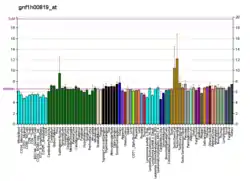SPZ1
Spermatogenic leucine zipper protein 1 is a protein that in humans is encoded by the SPZ1 gene.[5][6][7][8][9][10]
| SPZ1 | |||||||||||||||||||||||||
|---|---|---|---|---|---|---|---|---|---|---|---|---|---|---|---|---|---|---|---|---|---|---|---|---|---|
| Identifiers | |||||||||||||||||||||||||
| Aliases | SPZ1, NYD-TSP1, PPP1R148, spermatogenic leucine zipper 1, CILD38 | ||||||||||||||||||||||||
| External IDs | OMIM: 618068 MGI: 1930801 HomoloGene: 49934 GeneCards: SPZ1 | ||||||||||||||||||||||||
| |||||||||||||||||||||||||
| |||||||||||||||||||||||||
| |||||||||||||||||||||||||
| |||||||||||||||||||||||||
| Orthologs | |||||||||||||||||||||||||
| Species | Human | Mouse | |||||||||||||||||||||||
| Entrez | |||||||||||||||||||||||||
| Ensembl | |||||||||||||||||||||||||
| UniProt | |||||||||||||||||||||||||
| RefSeq (mRNA) | |||||||||||||||||||||||||
| RefSeq (protein) | |||||||||||||||||||||||||
| Location (UCSC) | Chr 5: 80.32 – 80.32 Mb | Chr 13: 92.57 – 92.58 Mb | |||||||||||||||||||||||
| PubMed search | [3] | [4] | |||||||||||||||||||||||
| Wikidata | |||||||||||||||||||||||||
| |||||||||||||||||||||||||
References
- GRCh38: Ensembl release 89: ENSG00000164299 - Ensembl, May 2017
- GRCm38: Ensembl release 89: ENSMUSG00000046957 - Ensembl, May 2017
- "Human PubMed Reference:". National Center for Biotechnology Information, U.S. National Library of Medicine.
- "Mouse PubMed Reference:". National Center for Biotechnology Information, U.S. National Library of Medicine.
- Hsu SH, Shyu HW, Hsieh-Li HM, Li H (Feb 2001). "Spz1, a novel bHLH-Zip protein, is specifically expressed in testis". Mech Dev. 100 (2): 177–87. doi:10.1016/S0925-4773(00)00513-X. PMID 11165476. S2CID 17206805.
- Sha JH, Zhou ZM, Li JM, Lin M, Zhu H, Zhu H, Zhou YD, Wang LL, Wang YQ, Zhou KY (Jun 2003). "Expression of a novel bHLH-Zip gene in human testis". Asian J Androl. 5 (2): 83–8. PMID 12778315.
- Hrabchak C, Varmuza S (Aug 2004). "Identification of the spermatogenic zip protein Spz1 as a putative protein phosphatase-1 (PP1) regulatory protein that specifically binds the PP1cgamma2 splice variant in mouse testis". J Biol Chem. 279 (35): 37079–86. doi:10.1074/jbc.M403710200. PMID 15226296.
- Horowitz E, Zhang Z, Jones BH, Moss SB, Ho C, Wood JR, Wang X, Sammel MD, Strauss JF 3rd (Apr 2005). "Patterns of expression of sperm flagellar genes: early expression of genes encoding axonemal proteins during the spermatogenic cycle and shared features of promoters of genes encoding central apparatus proteins". Mol Hum Reprod. 11 (4): 307–17. doi:10.1093/molehr/gah163. PMID 15829580.
- Hsu SH, Hsieh-Li HM, Huang HY, Huang PH, Li H (May 2005). "bHLH-zip transcription factor Spz1 mediates mitogen-activated protein kinase cell proliferation, transformation, and tumorigenesis". Cancer Res. 65 (10): 4041–50. doi:10.1158/0008-5472.CAN-04-3658. PMID 15899793.
- "Entrez Gene: SPZ1 spermatogenic leucine zipper 1".
Further reading
- Strausberg RL, Feingold EA, Grouse LH, et al. (2003). "Generation and initial analysis of more than 15,000 full-length human and mouse cDNA sequences". Proc. Natl. Acad. Sci. U.S.A. 99 (26): 16899–903. doi:10.1073/pnas.242603899. PMC 139241. PMID 12477932.
- Ota T, Suzuki Y, Nishikawa T, et al. (2004). "Complete sequencing and characterization of 21,243 full-length human cDNAs". Nat. Genet. 36 (1): 40–5. doi:10.1038/ng1285. PMID 14702039.
- Schmutz J, Martin J, Terry A, et al. (2004). "The DNA sequence and comparative analysis of human chromosome 5" (PDF). Nature. 431 (7006): 268–74. doi:10.1038/nature02919. PMID 15372022. S2CID 4373053.
- Gerhard DS, Wagner L, Feingold EA, et al. (2004). "The status, quality, and expansion of the NIH full-length cDNA project: the Mammalian Gene Collection (MGC)". Genome Res. 14 (10B): 2121–7. doi:10.1101/gr.2596504. PMC 528928. PMID 15489334.
This article is issued from Wikipedia. The text is licensed under Creative Commons - Attribution - Sharealike. Additional terms may apply for the media files.




